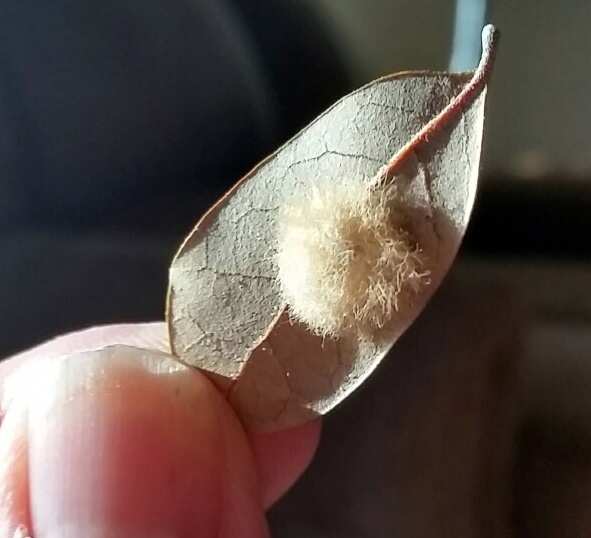Gopher plants generally do well in desert climate

Q: I found fuzzy things on my oak leaves. What are they and should I be concerned?
A: These are plant galls — swellings of plant tissue on the roots, stems, trunk, leaves and flowers. Galls can be caused by insects, diseases, nematodes or mites.
This particular gall is on heritage live oak. These leaf galls are very common to oak and caused by a tiny wasp. The gall’s purpose is protecting the developing youngster until it is mature and exits the gall to find a mate.
The basic life cycle begins with the female laying an egg on or inside a leaf. The egg hatches and the tiny larva eats inside the leaf. Eating releases chemicals that control the growth of the leaf around the youngster.
The leaf grows around the youngster in a tumor-like growth. Inside this gall, the youngster continues feeding but is protected from predators and the environment.
Eventually the adult exits the gall to pursue a mate. Once the mate is found, the life cycle repeats itself. In some cases, a large number of these wasps can cause leaf drop.
Leaf galls normally don’t present a problem and I would ignore them. However, if they are a problem, consider applying a systemic insecticide to the soil surrounding the tree near the source of irrigation water. Apply it as soon as you see leaf galls developing in the spring.
Q: My wife and I are fairly new to the valley. She is the gardener and we are trying to grow gopher plants in containers. The containers are about 12 inches in diameter and the plants are struggling. They are watered once every week or two and we added a plant tonic two weeks ago.
A: A gopher plant does very well in our climate when planted directly in the soil or in containers. Remember that the stems die after flowering. Flowering is normally in the spring and sometimes again in the fall.
Cut stems back to the ground after flowering. There will be small stems growing from the base. You must let these grow and not cut them back. Fertilize lightly after cutting back.
Gopher plants’ two basic problems are related to the soil used or irrigation practices.
If you water this plant too often, it will die. If you do not water it often enough, you will damage it. If the soil used does not drain easily, it will die. The usual reason for failure is watering too often and poor water drainage.
When planting this in a container, ensure that you use a soil mix made for this type of plant. A cactus and succulent soil mix would be preferred. The plant will struggle if you fail to improve the soil before planting.
The plant is easier to maintain if planted directly into the ground. Make sure you amend the soil so that it has good drainage. It will do well in a soil that contains compost.
The plant will handle low winter temperatures but could be damaged if winter temperatures get extremely low, into the teens for instance. Fertilize it with a cactus fertilizer such as Cactus Juice every two to three months when you water.
I have two or three postings about gopher plants on my blog. Type “gopher plant” into the search engine and see whether that information helps.
Q: I have a 16-year-old hedge of pyracantha. It grows underneath three large pine trees and gets little sun. The soil is mostly just rocks. The plant is thinning and getting bare in the center. The top is still fairly green. The amount of berries has been decreasing. Can you help?
A: Without seeing your plant, I am guessing its struggles relate to a combination of light as you mentioned, lack of soil improvement, perhaps irrigation and maybe improper pruning. There also could be borer problems.
What little sun it is getting is greening the plant’s top. Pyracantha needs a lot of sun. It is not a desert plant but in the rose family, so it likes improved soils. It likes surface mulches made of wood that can decompose.
Pruning is a tricky but stems should remain to shade the exposed trunk or major branches. Pyracantha handles pruning with a hedge shears nicely, but I don’t recommend this unless planted as a hedge.
If you have borer problems, you would see the trunk or major limbs with bark coming off and some darkened areas because of sunburn. Bayer makes an insecticide you can apply to the soil to get season-long control of borers.
Start by checking the irrigation and making sure the plant’s getting enough water or increase the amount it gets; the amount matters more than the frequency.
Pull rocks away from the plant and put down an inch of compost and 3 to 4 inches of wood mulch.
When pruning, remove a few larger limbs close to the trunk that are too close together or are struggling. Be careful of opening the canopy, which might allow the sun to burn the trunk and limbs and borers to cause further damage or death.
Fertilize once a year in the spring with a fertilizer for flowering woody plants. You can substitute with a rose fertilizer. Apply the Bayer insecticide as soon as you start to see new growth if borers are a problem.
Bob Morris is a horticulture expert living in Las Vegas and professor emeritus for the University of Nevada. Visit his blog at xtremehorticulture.blogspot.com. Send questions to extremehort@aol.com.